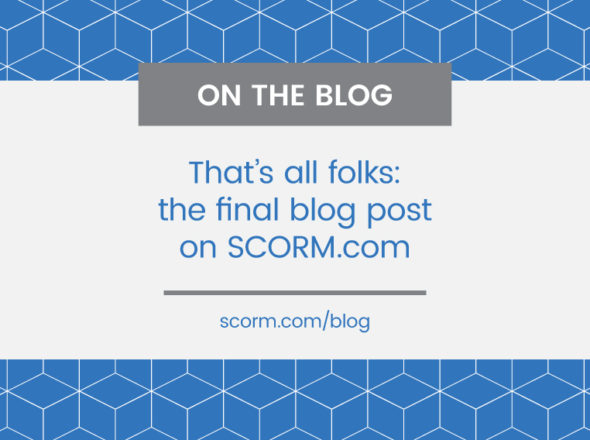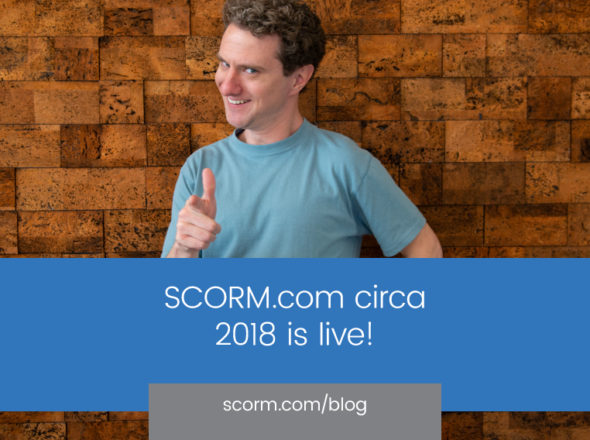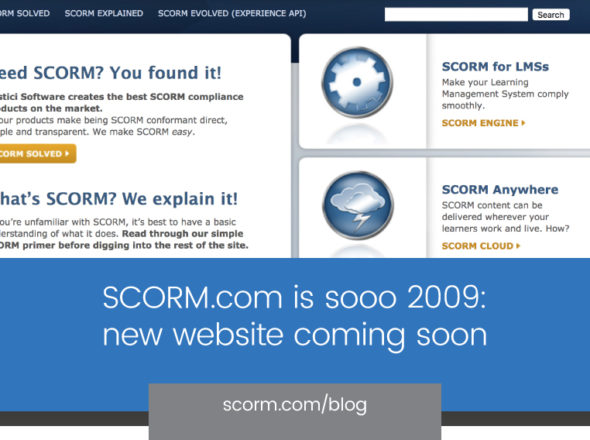A recent entry on “Rod’s Pulse Podcast” contained an audio interview with Dr. Bobbe Baggio, In the interview, Dr. Baggio asserts that “SCORM is dead”. She also says that “people who work with SCORM understand what I mean”. Dr. Baggio, I work with SCORM, I do understand what you mean and I do agree with your premise.
GASP! WHAT? The SCORM guy agrees with somebody who says that SCORM is dead! Hold on, don’t panic, catch your breath. I did not say that I agree that SCORM is dead, I said that I agree with her premise, and as we’ll see, those are two different things entirely.
Dr. Baggio’s central premise is that “intelligent searching has eclipsed the need for metadata and tags”. Amen, hallelujah. I absolutely agree. There are still some very valid uses for metadata, but for most of the world, intelligent searching will be good enough.
BUT, it is a long stretch to get from there to “SCORM is dead”. To make such a leap represents a misunderstanding of what SCORM is and why people use SCORM in the first place. It is an understandable misunderstanding though considering the way SCORM was initially “sold” to the world.
In Dr. Baggio’s view, SCORM is all about reuse. She views SCORM as being all about storing content in repositories to enable people to search those repositories and reuse content. Her postulation is that metadata is the key technological enabler of this functionality. I disagree with this view in three significant ways.
My first disagreement is that SCORM is all about reuse. Yes, reuse is one very significant goal of SCORM, but the real reason most people adopt SCORM is interoperability. Most people use SCORM so that they can import content created in any system into their LMS.
My second disagreement is with narrow definition of reuse contained in Dr. Baggio’s arguments. Dr. Baggio’s view of reuse is that an organization’s content is all stored in a central repository. Because of the content’s metadata that repository is easily searched, allowing people to find reusable learning objects to use in other courseware. This is certainly a valid type of reuse and it is the main view that has been “sold” by ADL as a driving factor behind SCORM. But, there are other types of reuse that are far more common in today’s world. For instance, SCORM enables courses to be reused as a whole and across entities. For instance, content vendors (like SkillSoft) can produce a huge library of content that is sold to thousands of organizations. Because of SCORM (and other standards), SkillSoft only needs to produce one version of that content and it can be used by many of organizations without modification. This is reuse. This is what is happening in the industry. This is what has made SCORM the de facto industry standard for learning content. This is what SCORM is really good at. This is why SCORM is healthy, viable and far from dead.
My final disagreement is with the implicit assertion that metadata is the key technological enabler behind SCORM and as such, since metadata isn’t necessary anymore, SCORM is dead. In my view, metadata is the least important aspect of SCORM considering the way SCORM is currently used by industry. Go ahead, take it away, it won’t affect things. As I previously argued, SCORM is about more than reuse and content discovery, so metadata’s irrelevance doesn’t kill SCORM. But, let’s assume for a moment that SCORM is only about reuse and discovery of reusable learning objects in a central repository. In other words, let’s step into the view that Dr. Baggio espouses. Even in that world, SCORM adds a lot of value if metadata is replaced by intelligent searching. SCORM encourages content to be logically chunked, enabling reuse. SCORM removes technical dependencies allowing content to be portable across different environments. The interoperability that SCORM provides is still required when the discovered content is to actually be used.
I don’t mean to disparage Dr. Baggio’s remarks because I completely understand where her opinions come from. SCORM was sold to the public to do precisely what she envisions. When SCORM was first released, all the hype was about reusable learning objects pulled from central repositories. Metadata and reuse were all the rage. That vision is still valid, but unfortunately it hasn’t emerged as we had hoped. (I believe the obstacles standing in the way of that vision are related more to business models and constraints than they are to technological deficiencies, but that’s another blog post.) Along the way though, the world found that SCORM was very useful in a world without central repositories. SCORM is VERY widely adopted and very widely used. This adoption has happened voluntarily by industry. Broad industry adoption simply does not happen unless there is significant value in a technology.
Dr. Baggio made several other comments that I disagree with, such as “SCORM from the beginning never really worked really well, “if SCORM is going to work in your organization, you have to go into SCORM and customize it to meet your needs”, “the need for SCORM has certainly gone away” and “if you look at the research about who uses SCORM, it’s not being used”. I disagree with all of these statements, but they do follow logically from her original premise. Since I’ve already argued against the root premise, I don’t think these comments need to be addressed.
I do agree with a few other things she said, such as “since SCORM was invented, we have better technologies” and “SCORM might morph into something else”. I absolutely agree with these assertions. SCORM is about 10 years old and due for some updating. I am very involved in the effort to define what SCORM 2.0 will look like. A new organization called LETSI has taken on that monumental task and their efforts have garnered a lot of support.
So, in short, I think that SCORM is anything but dead. A while back, we bet the company on SCORM’s future. Today I am much more inclined to double down than to walk away.


